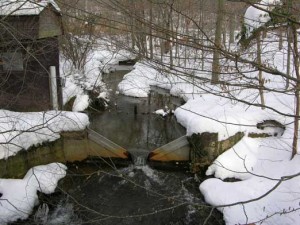An interview with Cindy Gilmour, mercury researcher.

Senior scientist Cindy Gilmour studies how anaerobic bacteria – found in places like the marsh soils above – transform mercury into methylmercury. Methylmercury poses a bigger problem than inorganic mercury because it bioaccumulates.
This January the Maryland Healthy Air Act goes into effect. It aims to significantly reduce emissions of air pollutants from the state’s coal-fired power plants. Mercury, like sulfur dioxides and nitrogen oxides, is one of the pollutants that can be released into the atmosphere during the combustion of coal and other fuels. The new law requires mercury emissions to be reduced by 80% now, and 90% by 2013, relative to a 2002 baseline. Maryland is just the latest to join a growing roster of states that have adopted tougher emissions regulations.
Cindy Gilmour will pay close attention to the impact of these new regulations on mercury levels in the Chesapeake Bay and its watersheds. Gilmour is a senior scientist at the Smithsonian Environmental Research Center (SERC), in Edgewater, Maryland. She took a few minutes to answer some questions about the science of mercury, why it’s of concern and what she does to monitor it in ecosystems.
How significant are coal-fired power plants as a source of mercury pollution?
They’re the biggest source of new mercury to the air in North America. We’ve been polluting our environment with mercury since the industrial revolution, so our soils and waters are contaminated, and they also re-emit old mercury pollution to the air.
Describe how mercury from coal-fired power plant emissions moves from the atmosphere and into an ecosystem.
Mercury is emitted from stacks in a number of forms, some of which are deposited nearby, and some that are transported around the globe. Most of the mercury pollution here in Maryland comes from our own power plants and power plants in states upwind, but some comes from other countries. China’s increasing use of coal is of concern.
Mercury in the atmosphere returns to the land and to the surface of our water bodies in rain and in particles. It is also absorbed directly from the atmosphere by plants, and sometimes deposited as particles. All the deposition that is not in rain is collectively called “dry deposition.”
You spend a lot of time studying mercury that gets converted into methylmercury (MeHg). What is methylmercury?
The chemical form of a metal matters a lot to how toxic it is and how much it accumulates in food webs. Mercury can exist in a variety of chemical forms. The one most people think of is the shiny liquid metal, called metallic mercury. The forms emitted by power plants are mercury gases and mercury salts that can dissolve in water. All of these are forms of inorganic mercury. The form of mercury that accumulates in our food is methylmercury, which is an organic form. It’s inorganic mercury with an organic (methyl) molecule attached to it.
Methylmercury is much bigger problem than inorganic mercury because it bioaccumulates. This means that the concentrations of methylmercury get higher and higher as you move up the food web. Methylmercury and PCBs are the pollutants with exceptionally high bioaccumulation factors.

Cindy Gilmour monitors mercury levels in Muddy Creek weekly. The water in this stream ultimately ends up in the Chesapeake Bay.
For example, in the Chesapeake Bay, the concentration of methylmercury in the water is tiny – generally less than one part per trillion. But the concentration in a big striped bass swimming in the Bay might be almost a part per million. The concentrations of methylmercury in fish are often a million times higher than the water they swim in. A little methylmercury goes a long way because of bioaccumulation.
We often think about bioaccumulation of mercury in fish, but mercury is also problem for many other animals that are at the top of a food web – including birds and amphibians.
How does methylmercury actually bioaccumulate?
It binds strongly to one of the amino acids in muscle proteins. One of the common misconceptions about mercury in fish is that you can cut away the fatty tissue and avoid mercury. That’s true for PCBs, but not mercury. The mercury is in the filets.
Animals have an easy time taking it up, but a difficult time getting rid of it. If you eat a fish that has MeHg in it, it will take about six months for your body to get rid of half of it.
How does mercury become methylmercury?
The transformation from inorganic to methylmercury has been the focus of my lab’s research. It’s is a microbial process. There are certain kinds of bacteria that cause this transformation. The bacteria are anaerobes; they grow in places that have no oxygen. You can find them in marsh soils, in the bottom sediments of bodies of water, and in ground water that becomes anaerobic.
One of the big remaining mysteries we’re trying to understand is the biochemical process that causes these bacteria to produce MeHg. We think it’s a mistake in their metabolism and that there are enzymes causing this to happen. That’s something we’re researching and want to know badly. It should help us better understand how to control methylmercury production in our ecosystems.
Describe some of the ways you’re measuring mercury levels here at the Smithsonian Environmental Research Center (SERC), near the Chesapeake Bay.

A high-tech bucket at the top of this tower allows Cindy Gilmour to measure how much mercury gets deposited when it rains.
To measure how much mercury is deposited in rain we have a fancy bucket perched above the tree canopy on a tower here at SERC. The bucket opens when a sensor gets wet, and closes when it dries. We collect samples from that every week, depending on rainfall. To determine how much dry deposition we have we still rely on computer models.
Then to measure how the mercury moves through the ecosystem, we collect weekly water samples at three streams on SERC’s property. This allows us to ask questions about how much mercury is retained in plants and soils and how much moves downstream. What we want to know is how the mercury that deposits on our ecosystems translates into risk for biota and people.
Will you be looking at your monitoring data to see whether mercury levels change with Maryland’s new coal-fired power plant emissions regulations?
Yes. The power plants monitor how much mercury comes out of their stacks. Those that have installed new equipment have already seen a decrease. Now the question is: are these new and costly emissions controls going to be effective in reducing mercury deposition onto landscape and into the food web? And how long will it take?
What are you doing to see if mercury levels change in animals like fish?
We developed a new fish monitoring program with the Maryland Department of Natural Resources to supplement DNR’s existing monitoring programs. In 2008, DNR began sampling one-year-old fish from the Chesapeake Bay and many of the state’s reservoirs for mercury analysis. We think that by looking at young fish each year, we’ll be able to detect changes in mercury levels rapidly and effectively. The young fish accumulate methylmercury for just one year, while older fish can integrate mercury over longer periods. DNR now collects young-of-the-year fish each summer from about 10 locations statewide for this program. That should hopefully tell us whether or not the new emissions regulations have a real impact over the next few years.
Do you think the coal-fired power plant emissions controls in Maryland will reduce mercury levels in region?
I hope we’ll see a measurable reduction in young of the year fish within the next five years. If that happens, it will be a big deal. For well over a century we’ve been polluting our environment with mercury, so if we can turn around mercury levels in five years – that’s pretty good. If it happens, it will be a success story for the Chesapeake Bay – and we need some of those!
-
- For a range of resources and information about mercury, visit the Environmental Protection Agency’s mercury home page.
-
- To find out about fish consumption advisories in the state of Maryland, visit the state’s Department of the Environment Web site.
- Return to the Smithsonian Environmental Research Center’s home page.


Good post. Thanks for sharing.
Environmental problems (including mercury) are pervasive nowadays and is now at levels completely unheard of just a few decades ago.
A toxic load of more than a hundred different foreign chemical substances are commonly found in populations in western societies and it is even worse in many developing nations.
The quantity of toxins we absorb each and every year which, for the average adult in developed countries, has been estimated at 6kg (or 13 lb) of artificial chemicals (http://bit.ly/189bmFW).
Using the World Bank’s (http://bit.ly/ZFujtt) average lifespan estimate of ~70 years, this is equal to an intake of more than 310kg (or over 680 lb) of artificial chemicals!
And it is our poor overworked livers that bear the brunt of protecting us from this onslaught.
It’s great to see the Maryland Healthy Air Act trying to make a real difference.
Lets hope other follow!
Olivia Samuals